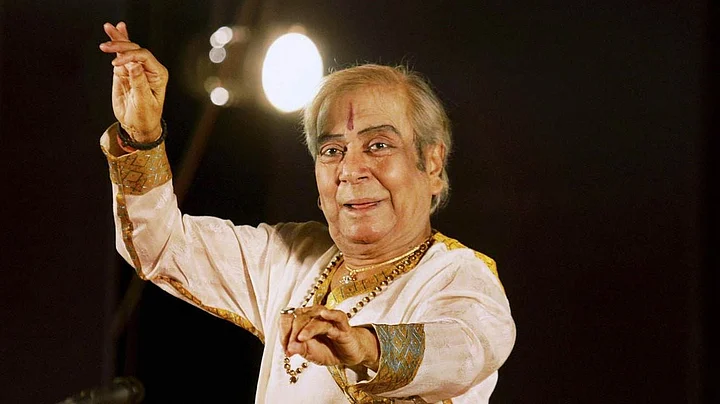The dance form of Kathak evokes the word Katha, or story, in Hindi. It is the dance form of storytellers, and this is the story of Kathak’s greatest storyteller, Pandit Birju Maharaj, who passed away in the early hours of Monday at his home in Delhi, at the age of 83.
Birju Maharaj was, without a doubt, the best-known exponent of Kathak. It is not often that someone born to such a tremendous legacy not only sustains it but also builds their own monumental legacy on its foundations. Birju Maharaj’s great grandfather, Thakur Prasad, danced in the court of Awadh’s last ruler, Wajid Ali Shah, and trained the Nawab in the dance form. Thakur Prasad’s sons, Kalka and Binadin, were also part of the Nawab’s court but made a name for themselves across the country. They went on to form the Kalka-Binadin Gharana, which was taken forward by Birju Maharaj’s father, Achchhan Maharaj, his uncles, Lachchu Maharaj and Shambhu Maharaj, and eventually him.
How Birju Maharaj Gave Women an Equal Space
The memories of his ancestors lived on in his work. More importantly, their experimentations and creations, and the history of the evolution of Kathak, became an integral part of his craft. Birju Maharaj not only kept the roots of Kathak alive, but he also crafted its future. Traditionally, Kathak has largely been a solo performer’s expression. Birju Maharaj introduced choreographies with multiple dancers on stage at the same time, grand productions, and the dance-drama style of production. These innovations arrested the waning popularity of the dance form and secured its place on the cultural map of the world.
His performances, however, are but one part of his legacy. Birju Maharaj, who started teaching Kathak at the age of 13, taught hundreds of students in his lifetime and ensured the survival of Kathak through his disciples. He was a polarising figure as a teacher – as most towering figures tend to be – but a great many Kathak stalwarts today owe him a tremendous debt. Among his legatees are women exponents such as Saswati Sen, who is perhaps his foremost disciple. This is significant because when Birju Maharaj started dancing, the world of Kathak was dominated by men. While proficient male dancers were hailed as maestros, women practitioners were looked down upon as tawaifs. Birju Maharaj has been part of the sea change that gave women an equal place on the stage.
'Don’t Hurry Kathak, Child'
No list of achievements, however, will accurately sum up his relationship with dance. He did not simply perform Kathak, he lived it. If you ever had the occasion to meet with him, you might have noticed that his fingers were always moving, as if his mind’s eye was watching an eternal performance. I was 13 when I first met him, the same age as he was when he started teaching Kathak.
He was visiting my guru Amala Shankar in Calcutta, and I happened to be rehearsing for an upcoming concert. He asked me about the piece I was to perform. I told him I knew it by heart. “Don’t hurry Kathak, child,” he said to me. “Take your time over it. Give it your whole life.”
I took his words to heart. At the time, I was learning four different dance forms, but I persisted with Kathak. As an adult, I moved from one city to another but did not give up on it. And, to date, I remain a disciple, learning from my third guru, Manjari Chaturvedi.
That said, it was not merely learning Birju Maharaj was referring to in our first encounter over two decades ago. Over the years, I realised that what he was really trying to drive home that afternoon was the importance of riyaaz (practice) – years spent perfecting and rehearsing the same gestures, the same footwork, over and over again.
A Life Consumed by One's Craft
A key component of Kathak is speed and accuracy. Birju Maharaj was not only a master of both, but he made the breathless precision of his movements look effortless. His commitment to riyaaz took him from being a gifted legatee to a grandmaster. But Birju Maharaj was not simply content with hours of practising the physical movements of Kathak – he composed music, wrote poetry, sang, and played the tabla. In short, there was no aspect of Kathak that he was not immersed in. He even painted, recreating themes from his dance pieces on canvas.
As he is laid to rest today, I think of a life spent consumed by one’s craft. I think of the privilege of being single-mindedly in love with what one does.
I also think of Lucknow, where Wajid Ali Shah, mentored by Birju Maharaj’s great grandfather, wrote and performed in a grand theatrical production on the romance between Krishna and Radha that lit up all of Qaiserbagh. The essence of Lucknow’s increasingly elusive past lived through Birju Maharaj’s body of work. Ultimately, I think of what makes him great in his death as he was in his lifetime. And the answer is the bequeathal of beauty. Of all the things to leave behind, nothing can quite match the gift of a sublime art form that encapsulates some of the finest creativity known to the world.
(Pragya Tiwari is a Delhi-based writer, who was formerly with Vice India. She tweets at @PragyaTiwari. This is a personal blog. The views expressed are the author’s own. The Quint neither endorses, nor is responsible for them.)
